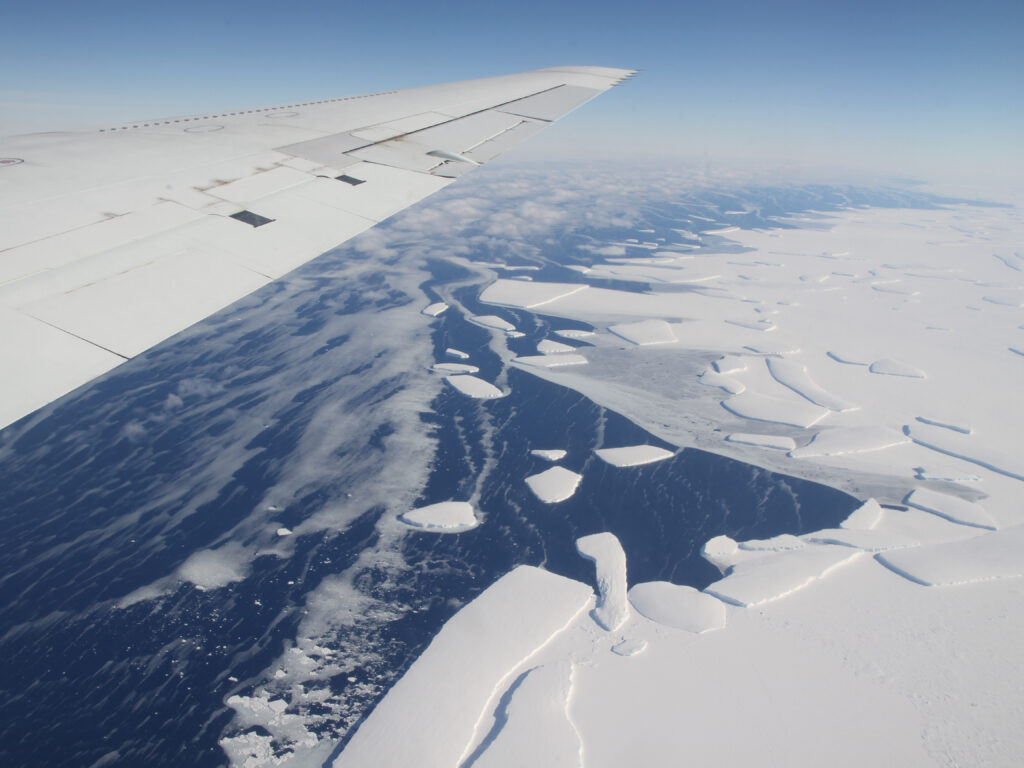By Brian Smith, UF College of Liberal Arts and Sciences
A recent study conducted by University of Florida geologists and geographers has shed new light on the effects of climate change on Antarctic ice shelves. It found that while there has been broad ice shelf loss due to warming temperatures, the frequency and size of major iceberg calving events has not changed significantly.
This study was led by Assistant Professor of Geological Sciences Emma MacKie, Ph.D., and Assistant Professor of Geography Katy Serafin, Ph.D., along with a collaborator at the Colorado School of Mines.
“Our results suggest that the primary threat to our ice shelves is ‘death by a thousand cuts’ via small calving events, rather than catastrophic extremes,” said MacKie.
Calving, when chunks of ice break off from ice shelves to form icebergs, is common and increasingly influenced by climate change. For extremely large icebergs, this process is typically slow, often starting with small rifts that spread across the ice shelf before fully breaking off.

These rifts can be detected as they form and grow using satellite data, but their random nature and the risks associated with sending scientists to observe them in-person make it extremely difficult to predict when future rifts or calving events may occur.
Major calving events are particularly challenging to study. While smaller calving events occur frequently, large events — where over 100 square kilometers of ice break away — are exceptionally rare.
This study is the first of its kind to focus on these large calving events. Even with 47 years’ worth of satellite data from 1976 to 2023, the team was still faced with a small sample size. This challenge was addressed with extreme value theory, a type of statistical analysis used when studying rare natural disasters like major earthquakes, extreme floods or volcanic eruptions.
As an expert on extreme flooding, Serafin was no stranger to this type of data analysis.
“Statistical models relating event size and frequency are tools that have been used for estimating rare flood events, like a 100-year flood, for decades,” said Serafin. “Now that satellite imagery can more consistently track large calving events, we thought we’d test whether we could apply the same tools for understanding how likely these massive calving events are.”
Using this method, the team analyzed extreme calving events found in the satellite record and developed a model to predict the likelihood of these events over time. While creating their models, researchers also developed scenarios to predict how large calving events could be.
By their estimates, a once in a decade iceberg could be as large as 6,100 square kilometers, only slightly larger than an extreme calving event in 2017, when an iceberg roughly the size of Delaware broke off the Antarctic ice sheet. A once in a century event could produce an iceberg about 45,000 square kilometers, slightly larger than the entire country of Denmark.
“A once in a century iceberg would be several times larger than any in the observational record and would have a significant impact on ice-sheet stability and ocean processes,” said MacKie.
The team found no evidence that large icebergs have increased in size over the last half century, with the peak iceberg surface areas occurring between 1986 and 2000. This indicates that extreme calving events do not correlate with climate change, although overall ice shelf loss has increased due to climate change.
While extreme calving events continue to be rare and may be part of a larger natural cycle, more numerous small calving events have dominated Antarctic ice shelf loss over the last half century.
This study was published Nov. 29 by the American Geophysical Union.
Banner image: A calving front of the Antarctic ice sheet (NASA Goddard Space Flight Center, Public domain, via Wikimedia Commons). This piece was originally published at https://news.clas.ufl.edu/death-by-a-thousand-cuts/.
Sign up for The Invading Sea newsletter by visiting here. To support The Invading Sea, click here to make a donation. If you are interested in submitting an opinion piece to The Invading Sea, email Editor Nathan Crabbe at nc*****@*au.edu.



